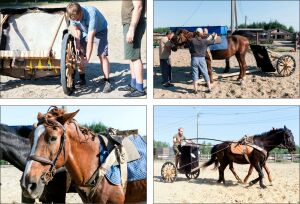 Igor V. Chechushkova,# and Ivan A. Semyanb,##
Igor V. Chechushkova,# and Ivan A. Semyanb,##
a Institute of History and Archaeology, Ural Branch of RAS, Yekaterinburg, Russia
b South Ural State University, Chelyabinsk, Russia
#Email: chivpost@gmail.com
##E-mail: ivansemyan@mail.ru
Keywords: the Bronze Age, chariot, experimental archaeology.
The paper presents the study of the Bronze Age chariot of the Sintashta-Petrovka period (the 2nd mil. BC) by means of the scientific experiment. The authors studied the bridle with cheekpieces as a control system of harnessed horses based on data of 28 chariot graves and a series of cheekpieces. It was found that soft bits with cheekpieces are more effective than a simple halter and less effective than modern metal bits. Based on ancient petroglyphs, a harness system of leather and felt was made; it was found suitable for chariot horses. Finally, field tests of a chariot proved it efficient and stable. The authors calculated the labour input of chariot preparation amounting to 250 hours of up to 6 people. Counting sicu operations as resource procurement and complete training, the preparation of the Bronze Age chariot had required at least 1–1.5 years of work by a team of 4–6 people.
DOI: 10.31857/S0869606322040079







